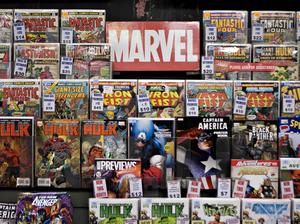
Stored in a Baltimore gallery is the original poster artwork for the 1937 classic Disney film “Snow White and the Seven Dwarfs,” and no one can see it but Steve Geppi.
Geppi, a serial collector and Baltimore entrepreneur specializing in comic books and collectibles, owns the one-of-a-kind piece. While most artwork and animation cels from other movies of that era were destroyed, Geppi said somehow this work of the children's book artist Gustaf Tenggren has survived.
“It was a fluke that this thing exists,” he said.
Geppi knows there are Snow White fans across the globe, and it doesn’t sit well with him that no one has access to what he believes is a unique, highly valuable piece of cinematic history.
The average fan could never afford a collectible like this, he said, but they might settle for a piece of it.
That’s why Geppi said he’s staking his credibility as an industry leader on what he himself only recently thought was a crazy idea: Non-fungible tokens, or NFTs.
Unlike a dollar bill, which can be exchanged for any other dollar bill, an NFT is a singular digital item. People and companies are turning images, artwork, music, videos and more into NFTs and selling them using cryptocurrency and blockchain technology. Someone spent $230,023 to buy a video of Lebron James dunking on the Miami Heat through an NFT platform run by the National Basketball Association. In September, Sotheby’s auctioned off a set of NFT artwork titled “Bored Ape Yacht Club” for more than $24 million.
At first, Geppi thought NFTs sounded “crazy,” but the skeptic has turned true believer. The Snow White poster artwork is his first piece to be sold as an NFT, but more could follow. (Outside of selling NFTs, Geppi is the CEO of Geppi Family Enterprises, which includes Diamond Comic Distributors Inc. and Baltimore magazine.)
In the third quarter of 2021, the trading volume of NFTs topped $10 billion, CNBC reported in October, a more than 700% increase from the previous quarter. In November, Markets Insider reported JPMorgan had valued the NFT market at $7 billion.
Geppi thinks NFTs could have a huge impact on the comic book and collectible industry, and he wants to lead the way.
“I believe that it does have legs,” Geppi said. “I want to be on the train and I want my industry to be on the train… We’re the most likely industry to benefit from [NFTs].”
Imagine traveling back to 1962, Geppi said, and telling the guy who just printed a 20-cent copy of Amazing Fantasy #15 that this comic book — which featured a new hero called Spider-man — would one day sell for $3.6 million.
That guy wouldn’t believe it, Geppi said, and this is what it’s like explaining NFTs to people today.
So how much is the original 1937 artwork of a Snow White poster worth? And how much would its NFT be worth? Geppi said he bought the artwork “many, many, many years” ago for a six-figure price and estimates it’s worth far more now.
The price of the NFT is more complicated.
On Monday, InTrove released the Snow White NFT as the first piece of the Geppi Treasury. InTrove is run by Adam Fortier, the man who convinced Geppi that NFTs aren’t a scam.
When they priced the Snow White NFT, they didn’t use U.S. dollars. They pegged its value to 3,000 Ethereum, a cryptocoin used to buy NFTs.
A year ago, a single Ethereum was worth less than $600.
When the Snow White NFT went on sale on Monday at 11 a.m., Ethereum was worth about $4,165.
That put the Snow White NFT at a valuation of nearly $12.5 million. The price of Ethereum has increased slightly since then, meaning the valuation of the Snow White NFT was more than $13 million as of Wednesday.
The plan is to release chunks of the Snow White NFT for sale over time. Eventually, if all the fractional stakes are bought, there will be a secondary market of people selling their ownership stakes to other interested investors or collectors.
"I think bragging rights are part of it,” Geppi said, noting it could make a good conversation topic at a party.
Geppi said he’s not interested in making a quick buck. He thinks there will be long-term interest in these items — and he has lots of collectibles that could be sold as NFTs. In 2018, for example, Geppi donated 3,000 pieces to the Library of Congress, which described it as a multimillion-dollar donation.
“Whatever comes out of Geppi Treasury is going to be pretty unique,” Geppi said.
One item he wants to sell as an NFT is Elvis Presley’s 16-millimeter reel of the 1956 movie “Love Me Tender," which Presley starred.
As of now, there’s not a timetable to release more NFTs. For this to be successful, Geppi said they need to first educate collectors about cryptocurrency, NFTs and Ethereum, and that could take time.
“This was more of a prove-it-works kind of a thing first,” Geppi said of the Snow White NFT.
So how is that sale going?
Two days in, less than one tenth of 1% of the NFT has sold.
Investors, collectors and curious onlookers can claim their piece of cinematic art history by clicking here.










